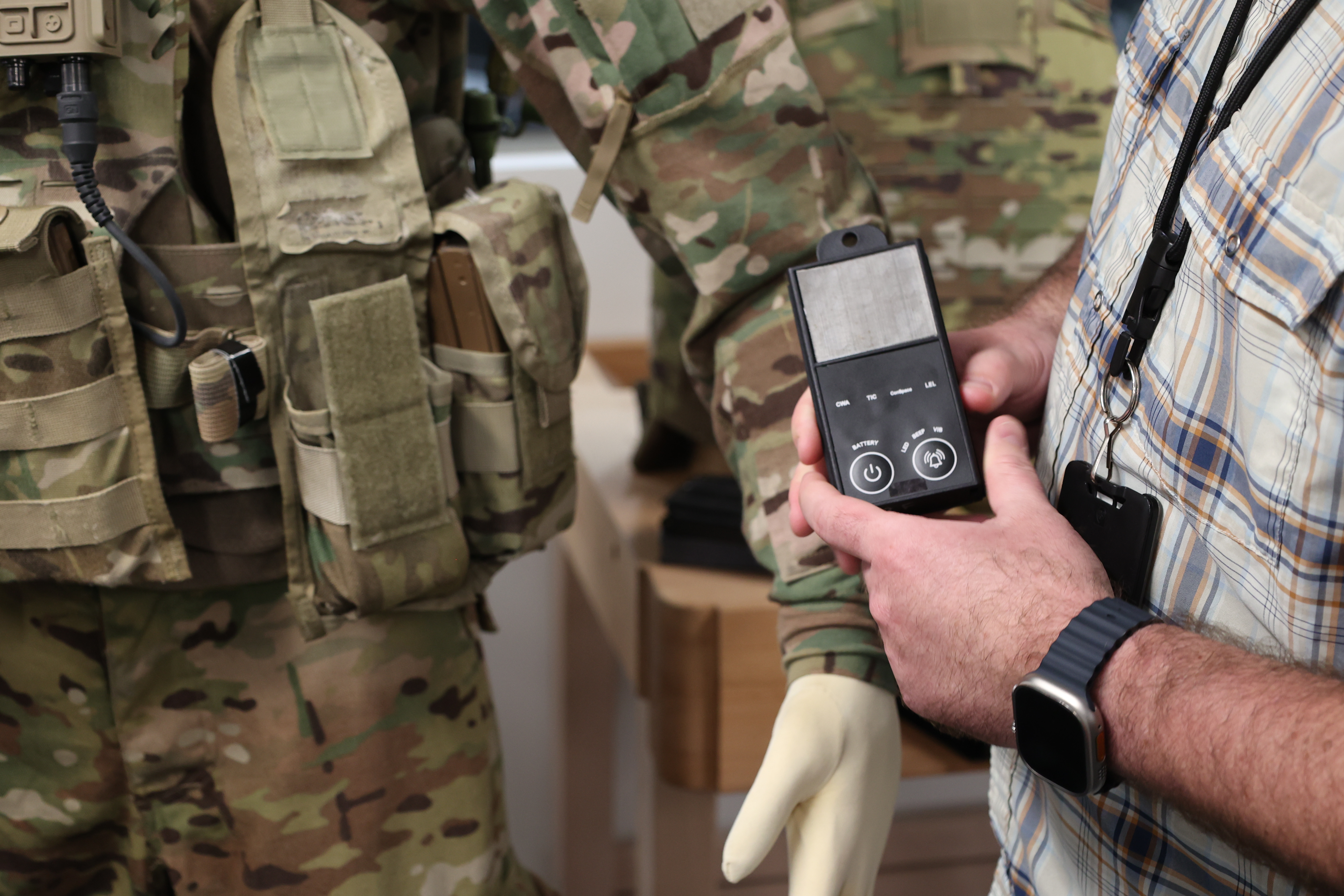With threats evolving, equipping warfighters to be ready to respond to several seen and unseen threats without increasing their physical burden, remains a top priority for the Department of Defense (DOD). The Compact Vapor Chemical Agent Detector (CVCAD) is a program of record that is currently funded and managed by the Joint Program Executive Office for Chemical, Biological, Radiological and Nuclear Defense (JPEO-CBRND) and the Defense Threat Reduction Agency (DTRA) Joint Science and Technology Office which aims to provide chemical and confined space hazard detection capability to alert warfighters without introducing any hinderances that may interfere with their ability to carry out their mission. For example, CVCAD’s small size allows it to be seamlessly person-worn unobtrusive device without impeding awareness or focus.
The CVCAD is an iPhone-sized tool made to detect potential chemical threats for general and specialized forces in all service branches. Currently, several prototypes exist and are currently in a design phase to confirm the most optimal wear for the device to be placed on a warfighter. The small size allows the device to be mounted or used for unmanned operations. This means a Soldier can wear the CVCAD on their person or mount it to a vehicle or an unmanned system like an unmanned aerial vehicle (UAV).
All that functionality ensures Warfighters can be alerted to any chemical hazard or CBRN denied environment across multiple domains, preventing unnecessary exposures. These alerts can be configured to be haptic, visual, or auditory, based on specific environments for technical and combat forces. For example, if an infantry needs to be quiet in battle, only haptic alerts will be made to ensure the mission is not compromised by the CVCAD’s alert system.

Before any piece of equipment is fielded for use, it must be tested and scrutinized to ensure it is effective in any environment and does not inhibit physical movement or cause challenges with a Warfighter’s kit. These rigorous tests are a requirement to ensure warfighter lethality and overmatch in the field.
On May 3, 2023, JPEO-CBRND partnered with Program Executive Office (PEO) Soldier to evaluate placement of CVCAD on soldiers. This meeting was a critical step to understand how the CVCAD could be used on a soldier, initially with mannequins to evaluate CVCAD positioning and other aspects that will inform future design adjustments.
The engagement, which took place at the Soldier Integration Facility (SIF) at Fort Belvoir, VA, had three objectives: to assess CVCAD system placement, pave the way for future engagements with Soldiers, and evaluate future CVCAD positioning as a worn CBRN detector.
“Early collaboration with PEO soldier is tremendously beneficial to the CVCAD program to inform design considerations for current and future soldiers intended to wear the CVCAD,” said Kia Hopkins, CVCAD Team Lead.
To get the best results, the CVCAD needed to be evaluated in an environment Soldiers could face in the field. The SIF was a perfect place for this evaluation to take place. The SIF is designed for problem solving and sourcing first-hand warfighter on gear. It is a high-tech space with multiple virtual capabilities created for iterative problem solving. The SIF’s various design software and hardware allow for real-time updates to be made during testing and help answering the question, “what would happen if?”
“Tools like CVCAD must be evaluated and integrated within the Soldier’s kit as early as possible,” said Hopkins. “Our goal is to add capability, not a burden, and the best way for us to ensure that is to start to look at incorporating this kind of equipment into the kit as early as possible. The Soldier Integration Facility was the best place for us to have those conversations.”
The CVCAD testing conducted at the SIF proved to be a success in identifying key enhancements required to optimize the device for the field, including reducing its weight and improving its functionality. The feedback gathered will be used to create updated prototypes, and the next phase of the process will involve human testing.

An engagement like this doesn’t happen without the coordination and partnership between multiple organizations. JRO, JPEO-CBRND, DEVCOM Soldier Center (SC), and PEO Soldier came together to facilitate this initial engagement and pave the way for future enhancements to the CVCAD product and for its ease of use, cohesion, and protection to the Soldier as a part of the future combat uniform.
DTRA JSTO and JPEO-CBRND funded and manage the CVCAD program; DEVCOM SC, which specializes in developing and fielding the CBRN protective equipment that soldiers wear, provided much needed insights into how the CVCAD could be properly incorporated on uniform and equipment for optimal effectiveness; DEVCOM CBC with subject matter expertise, and PEO Soldier, manages the SIF where the testing was able to take place in a rigorous and collaborative environment.
This style of teamwork, partnership, and the sharing of resources and knowledge between organizations is a great example of how the United States Chemical and Biological Defense Program runs and is germane to the success of the entire program.
As of FY23, the CVCAD is completing technology development phase and is on track to transition into Full Operational Capability in FY38.